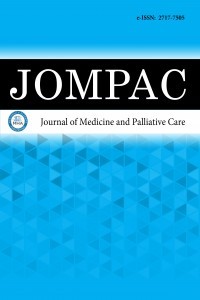Tip 2 diyabette yeni tedavi yaklaşımları: olgu örnekleriyle bakış
Tip 2 diyabet birden fazla organı etkileyen mültisitemik bir hastalıktır. Obezite günümüzün en önemli sağlık problemlerinden biridir ve sıklığı giderek artmaktadır (1,2). Obezitedeki artış buna paralel diyabet, hipertansiyon, kalp hastalıkları gibi hastalıklarda artışa yol açması yanında kas-eklem problemleri ve pek cok başka olumsuz duruma da yol açmaktadır. Tip 2 diyabetli hastaların büyük kısmı fazla kilolu veya obezdir. Obezite, insülin direnci, reaktif hipoglisemiler, yeme atakları gibi durumlar nedeniyle bu hastalar her geçen gün daha fazla kilo almakta ve bu durum da diyabette progresyona ve kan şekeri regülasyonunda zorluklara yol açmaktadır. Bu kısır döngü tersine döndürülürse hastalarda zaman içinde daha kalıcı bir tedavi ve daha iyi sonuçlar elde edilebilir. Bu bağlamda yüksek doz insülin kullanan ve yıllar içinde gittikçe daha kilolu hale gelen hastalarda yeni yaklaşımlarla kilo verdirip bu kısır döngüyü tersine döndürdüğümüz birkaç örnek ile sunmak istedik.
Anahtar Kelimeler:
Tip 2 diyabet, yeni tedaviler, obezite, kilo kontrolü
New treatment approaches in type 2 diabetes: an aspect to case studies
Type 2 diabetes is a multicitemic disease that affects more than one organ. Obesity is one of the most important health problems of today and its frequency is gradually increasing. In addition to the increase in obesity, it causes an increase in diseases such as diabetes, hypertension, heart diseases, as well as muscle-joint problems and many other negative conditions. The majority of patients with type 2 diabetes are overweight or obese. Due to conditions such as obesity, insulin resistance, reactive hypoglycaemia, eating attacks, these patients gain more weight every day and this leads to progression in diabetes and difficulties in blood sugar regulation. If this vicious cycle is reversed, patients may achieve a more permanent treatment and better results over time. In this context, we wanted to lose weight with new approaches and to reveal this vicious cycle in patients who use high doses of insulin and become more and more over the years.
Keywords:
Type 2 diabetes, new treatments, obesity, weight control,
___
- 1. Türkiye Endokrinoloji ve Metabolizma Derneği (TEMD). Diabetes Mellitus ve Komplikasyonlarının Tanı, Tedavi ve İzlem Kılavuzu-2019.
- 2. Balkau B. The DECODE Study. Diabetes epidemiology: collaborative analysis of diagnostic criteria in Europe. Diabetes Metab. 2000 Sep; 26: 282-6.
- 3. Williams G, Pickup JC. Diyabet El Kitabı, 3. Baskı. (Çeviri ve Türkçe Ed: Karşıdağ K, Toktaş T, Altunöz ME). Blackwell Publishing, 2004, ABD. 4. World Health Organization. WHO Study Group on Prevention of Diabetes Mellitus. Tech Rep Ser 1994; 844.
- 5. Expert Committee on the Diagnosis and Classifcation of Diabetes Mellitus: Follow-up report on the diagnosis of diabetes mellitus. Diabetes Care 2018; 41: 13–27.
- 6. Goldstein JB, Müller-Wieland D. Tip 2 Diyabet (Çev. ed: Akman C), A. Martin Dunitz London and New York 2004; 3-11. 7. Yenigün M. Her Yönüyle Diabetes Mellitus. Nobel Tıp Kitabevi 2001; İstanbul.
- 8. Demirel M, Şatır E, Uçak S, Saler T, Altuntaş Y. İnsülin tedavisi başlanan diabet hastalarında kilo değişimi ve bunu etkileyen parametrelerin irdelenmesi. Şişli Etfal Tıp Bült 2009; 43: 14-9.
- 9. Kefeli A, Bambul N, Çiftçi H, Oğuz A. Tip 2 diabetes mellituslu hastalarda farklı insulin tedavi protokollerinin kilo alımı ile ilişkisi. Göztepe Tıp Derg 2009; 24: 183-91.
- 10. The world health report 2006: working together for health. Geneva: World Health Organisation, 2006 http://www. who.int/whr/2006/whr06 en.pdf.
- 11. Roden M, Stingl H, Chandramouli V, et al. Effects of free fatty acid elevation on postabsorptive endogenous glucose production and gluconeogenesis in humans. Diabetes 2000; 49: 701-7.
- 12. DerSimonian R, Laird N. Meta-analysis in clinical trials. Control Clin Trials 1986; 7: 177–88.
- 13. Higgins JP, Thompson SG, Deeks JJ, Altman DG. Measuring inconsistency in meta-analyses. BMJ 2003; 327: 557–60.
- 14. Öz B, Karataş A, Akar ZA, Koca SS. Obezite ve kas-iskelet sistemi. Fırat Med J 2018; 23: 42-7.
- Başlangıç: 2020
- Yayıncı: MediHealth Academy Yayıncılık
Sayıdaki Diğer Makaleler
Hepatorenal sendromlu hastada terlipressin’e bağlı skrotal ağrı
Rabia EZBER, Güray CAN, Zuhal MERCAN, Gizem KAHVECİ, Fatime DEMİR, Müjgan GÜRLER, Meral AKDOĞAN KAYHAN
Malnütrisyonun tanımı ve hastaların yönetimi
Hasta değerlendirmede hekimlik sanatı: semptoma multisistemik yaklaşım
Güray CAN, Ayten ÜSTÜNDAĞ, Gülbin ÜNSAL, Ali Rıza SOYLU, Hasan Celalettin ÜMİT, Hüseyin Ahmet TEZEL
Tip 2 diyabette yeni tedavi yaklaşımları: olgu örnekleriyle bakış
